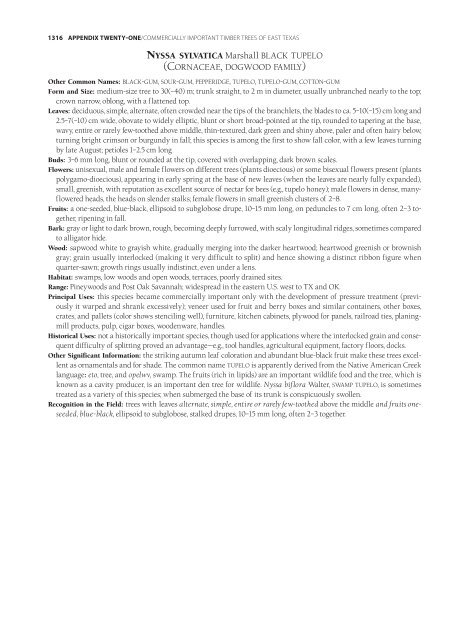Appendices & Glossary - Botanical Research Institute of Texas
Appendices & Glossary - Botanical Research Institute of Texas
Appendices & Glossary - Botanical Research Institute of Texas
Create successful ePaper yourself
Turn your PDF publications into a flip-book with our unique Google optimized e-Paper software.
1316 APPENDIX TWENTY-ONE/COMMERCIALLY IMPORTANT TIMBER TREES OF EAST TEXAS<br />
NYSSA SYLVATICA Marshall BLACK TUPELO<br />
(CORNACEAE, DOGWOOD FAMILY)<br />
Other Common Names: BLACK-GUM, SOUR-GUM, PEPPERIDGE, TUPELO, TUPELO-GUM, COTTON-GUM<br />
Form and Size: medium-size tree to 30(–40) m; trunk straight, to 2 m in diameter, usually unbranched nearly to the top;<br />
crown narrow, oblong, with a flattened top.<br />
Leaves: deciduous, simple, alternate, <strong>of</strong>ten crowded near the tips <strong>of</strong> the branchlets, the blades to ca. 5–10(–15) cm long and<br />
2.5–7(–10) cm wide, obovate to widely elliptic, blunt or short broad-pointed at the tip, rounded to tapering at the base,<br />
wavy, entire or rarely few-toothed above middle, thin-textured, dark green and shiny above, paler and <strong>of</strong>ten hairy below,<br />
turning bright crimson or burgundy in fall; this species is among the first to show fall color, with a few leaves turning<br />
by late August; petioles 1–2.5 cm long<br />
Buds: 3–6 mm long, blunt or rounded at the tip, covered with overlapping, dark brown scales.<br />
Flowers: unisexual, male and female flowers on different trees (plants dioecious) or some bisexual flowers present (plants<br />
polygamo-dioecious), appearing in early spring at the base <strong>of</strong> new leaves (when the leaves are nearly fully expanded),<br />
small, greenish, with reputation as excellent source <strong>of</strong> nectar for bees (e.g., tupelo honey); male flowers in dense, manyflowered<br />
heads, the heads on slender stalks; female flowers in small greenish clusters <strong>of</strong> 2–8.<br />
Fruits: a one-seeded, blue-black, ellipsoid to subglobose drupe, 10–15 mm long, on peduncles to 7 cm long, <strong>of</strong>ten 2–3 together,<br />
ripening in fall.<br />
Bark: gray or light to dark brown, rough, becoming deeply furrowed, with scaly longitudinal ridges, sometimes compared<br />
to alligator hide.<br />
Wood: sapwood white to grayish white, gradually merging into the darker heartwood; heartwood greenish or brownish<br />
gray; grain usually interlocked (making it very difficult to split) and hence showing a distinct ribbon figure when<br />
quarter-sawn; growth rings usually indistinct, even under a lens.<br />
Habitat: swamps, low woods and open woods, terraces, poorly drained sites.<br />
Range: Pineywoods and Post Oak Savannah; widespread in the eastern U.S. west to TX and OK.<br />
Principal Uses: this species became commercially important only with the development <strong>of</strong> pressure treatment (previously<br />
it warped and shrank excessively); veneer used for fruit and berry boxes and similar containers, other boxes,<br />
crates, and pallets (color shows stenciling well), furniture, kitchen cabinets, plywood for panels, railroad ties, planingmill<br />
products, pulp, cigar boxes, woodenware, handles.<br />
Historical Uses: not a historically important species, though used for applications where the interlocked grain and consequent<br />
difficulty <strong>of</strong> splitting proved an advantage—e.g., tool handles, agricultural equipment, factory floors, docks.<br />
Other Significant Information: the striking autumn leaf coloration and abundant blue-black fruit make these trees excellent<br />
as ornamentals and for shade. The common name TUPELO is apparently derived from the Native American Creek<br />
language: eto, tree, and opelwv, swamp. The fruits (rich in lipids) are an important wildlife food and the tree, which is<br />
known as a cavity producer, is an important den tree for wildlife. Nyssa biflora Walter, SWAMP TUPELO, is sometimes<br />
treated as a variety <strong>of</strong> this species; when submerged the base <strong>of</strong> its trunk is conspicuously swollen.<br />
Recognition in the Field: trees with leaves alternate, simple, entire or rarely few-toothed above the middle and fruits oneseeded,<br />
blue-black, ellipsoid to subglobose, stalked drupes, 10–15 mm long, <strong>of</strong>ten 2–3 together.
















